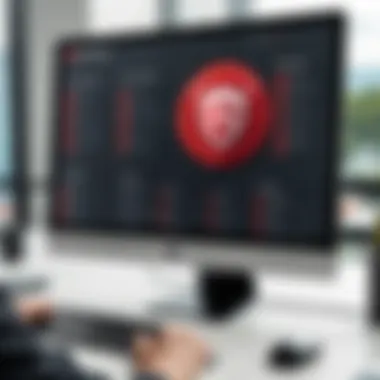Symantec vs. McAfee: In-Depth Cybersecurity Comparison


Intro
In today's digital landscape, where cyber threats loom larger than ever, the need for robust cybersecurity solutions cannot be overstated. Businesses are increasingly targeting by sophisticated attackers, making it vital for decision-makers to adopt effective security measures. This analysis delves into two of the leading cybersecurity software providers: Symantec and McAfee. Both companies offer a range of solutions designed to safeguard businesses from ever-evolving threats. The objective here is to illuminate the features, strengths, and weaknesses of each option. In addition, by examining key aspects such as threat detection capabilities, user experience, integration potential, and pricing structures, this article aims to provide valuable insights for B2B companies seeking to make an informed choice.
Key Features
Overview of Features
Symantec and McAfee both possess a rich set of features that cater to various organizational needs. Symantec, known for its deep expertise, offers solutions that encompass malware protection, firewall security, and endpoint detection and response (EDR). Its advanced threat protection includes machine learning and AI-powered capabilities that help in identifying and mitigating potential threats before they cause damage.
On the other hand, McAfee also provides a comprehensive suite of protection. Its offering includes cloud security, data loss prevention, and identity protection. Additionally, McAfee emphasizes user-friendly interfaces and seamless installation processes. This makes it appealing for small to medium-sized enterprises (SMEs) that may not have extensive IT resources.
Unique Selling Points
Both software solutions have distinct advantages:
- Symantec:
- McAfee:
- Excellent reputation in anti-virus protection.
- Specialized tools for enterprise-level environments.
- Strong emphasis on identity protection and regulatory compliance.
- Focus on a unified security platform, reducing complexity.
- Competitive pricing for SMEs.
- Effective threat intelligence that updates in real-time.
Each company presents unique propositions that cater to different market segments. Evaluating these selling points can help businesses align their specific needs with the strengths of each solution.
Pricing Structure
Tiered Pricing Plans
Understanding the pricing structure is crucial for firms planning to invest in cybersecurity. Symantec typically adopts a tiered pricing model where different packages are designed for varying business sizes and complexities. Companies can choose from basic protection plans to more advanced comprehensive solutions.
Conversely, McAfee also provides tiered options, enabling flexibility based on company requirements. Either way, organizations can find packages that fit their budget without compromising on security effectiveness.
Features by Plan
Each tier of the pricing plans features distinct benefits. For instance:
Symantec Plans:
- Basic:
- Advanced:
- Essential antivirus protection.
- Basic firewall options.
- Endpoint detection and response.
- Comprehensive regulatory compliance features.
McAfee Plans:
- Starter:
- Business:
- Basic malware protection and web security.
- Advanced data protection and user management tools.
Preamble to Cybersecurity Solutions


In today's business landscape, the significance of cybersecurity cannot be overstated. With the rapid digitization of operations and the ubiquitous use of technology, enterprises face an ever-evolving flood of cyber threats. Thus, making informed choices regarding cybersecurity solutions becomes critical. This introduction lays the groundwork for understanding how to assess tools like Symantec and McAfee when securing delicate business information.
Effective cybersecurity software is not merely a protective measure; it enhances operational efficiency by mitigating risks that could lead to financial loss and reputational harm. Companies need to prioritize solutions that not only protect against malware and breaches but also adapt to the dynamic nature of threats. Both Symantec and McAfee offer compelling products designed for such challenges, but each has unique attributes that cater to different needs.
Getting familiar with the available cybersecurity solutions provides businesses with valuable insights. It empowers decision-makers to align their cybersecurity strategies with organizational goals, thereby ensuring optimal resource allocation. Additionally, understanding the broader landscape of cybersecurity helps unlock best practices and innovative approaches to protection.
Uniquely, this article unpacks key elements of Symantec and McAfee, presenting a detailed evaluation framework that will assist executives and IT leaders in their quest for robust solutions. The wealth of information presented will not only highlight current capabilities but will also anticipate future needs, a crucial aspect of long-term security planning.
Understanding Symantec
In the crowded landscape of cybersecurity solutions, Symantec stands out as a prominent player. Its significance in this analysis stems from not only its long history in the cybersecurity sector but also its comprehensive range of features that cater to diverse organizational needs. Understanding Symantec is crucial for decision-makers as it provides insights into how the software can protect against cyber threats, ensuring business continuity and data integrity.
History and Development
Symantec’s journey began in 1982 as a company focused on software development. Over the years, it expanded its portfolio to include security software, adapting to the changing digital landscape. The acquisition of Veritas in 2005 marked a significant turning point, allowing Symantec to integrate data protection capabilities into its offerings. As one of the pioneers in antivirus software, Symantec has continually evolved, incorporating advanced technologies such as artificial intelligence and machine learning to enhance threat detection.
Core Features of Symantec Software
The core features of Symantec software are designed to provide robust protection against a variety of cyber threats. Key functionalities include:
- Antivirus and Antimalware: Symantec’s threat detection technology uses heuristic analysis and behavior monitoring to identify potential threats in real-time.
- Firewall Protection: The software includes advanced firewall settings to monitor incoming and outgoing traffic, ensuring that unauthorized access is blocked.
- Data Loss Prevention: Symantec actively safeguards sensitive information, reducing the risk of data breaches.
- Web Security: Features such as URL filtering protect users from accessing harmful websites, enhancing overall cybersecurity posture.
These features work in unison to provide comprehensive protection to organizations, enabling them to defend against a broad spectrum of cyber threats.
User Experience and Interface Design
Symantec prioritizes user experience, ensuring its software is accessible and easy to navigate. The interface is designed for functionality, allowing users to manage security settings effortlessly. The dashboard provides a clear overview of the system’s status, highlighting threats and security events in real-time.
Additionally, the installation process is streamlined, making it more approachable for non-technical users. However, some advanced features may require more technical expertise, which could be a consideration for smaller businesses with limited IT support.
Integration with Existing Systems
Integration capabilities are crucial for organizations that rely on a diverse range of software solutions. Symantec offers seamless compatibility with various operating systems and business applications. Its APIs allow for integration with existing security solutions and IT management platforms, enhancing overall efficiency.
This compatibility is especially important for larger enterprises that use multiple systems to operate their daily functions. By ensuring that Symantec can work in conjunction with pre-existing tools, organizations can leverage their current investments while enhancing their cybersecurity posture.
Exploring McAfee
In the landscape of cybersecurity solutions, understanding McAfee is crucial for organizations aiming to protect their digital assets. The importance of this exploration lies in McAfee's suite of tools that provide comprehensive security features. Firms seeking to optimize their defenses must consider how McAfee compares both technologically and functionally against other solutions like Symantec.
By evaluating McAfee, businesses can assess crucial aspects such as threat detection capabilities, user interface design, and integration with existing systems. Each of these elements contributes to the overall effectiveness and usability of a cybersecurity platform. Furthermore, consideration of McAfee's development history and core features enables decision-makers to make informed choices.
History and Development
McAfee's journey began in 1987 when John McAfee founded the company, initially focusing on antivirus software. Over the years, McAfee evolved alongside the rapidly changing cybersecurity landscape. Various acquisitions, such as that of Network Associates and Intel Security, expanded its reach and capabilities. In 2017, Intel spun off McAfee as a standalone business, allowing it to pivot towards innovative security solutions tailored for modern threats. This history reflects an ongoing commitment to adapt and advance in an era where cyber threats are increasingly sophisticated.
Core Features of McAfee Software
McAfee offers a range of core features aimed at providing comprehensive protection for enterprises. Key attributes include:
- Antivirus Protection: Real-time scanning to detect and eliminate malware.
- Firewall Defense: Monitors inbound and outbound traffic to block unauthorized access.
- Web Protection: Shields users from visiting malicious websites.
- Data Encryption: Guards sensitive information against unauthorized access.
- Threat Intelligence: Leverages global threat data to enhance detection capabilities.
These features work together to create a layered security approach, vital in defending against diverse cyber threats.


User Experience and Interface Design
User experience is a vital part of any software solution, including cybersecurity applications. McAfee has made strides in providing an intuitive interface that streamlines user interactions. The dashboard is designed for ease of access, allowing users to quickly assess security statuses and alerts.
Feedback from users indicates that simple navigation reduces the learning curve, enabling teams to deploy protections with minimum downtime. However, some have noted occasional clutter in the display, particularly for those unfamiliar with extensive security features.
Integration with Existing Systems
Integration capabilities are crucial for cybersecurity solutions. McAfee supports compatibility with various operating systems and platforms, including Windows, macOS, and Linux. Moreover, its cloud capabilities allow for safe interaction with popular enterprise applications.
A notable advantage is the ease of integration with other McAfee products, creating a cohesive security ecosystem. Businesses often find that seamless integration minimizes operational interruptions while ensuring robust protection across their IT environment.
Comparative Analysis of Symantec and McAfee
The comparative analysis of Symantec and McAfee is significant in this discourse, as it allows organizations to weigh the strengths and weaknesses of both cybersecurity solutions. In a landscape where cyber threats are not just increasing but evolving rapidly, understanding how these two giants perform is essential for businesses looking to secure their networks. A robust analysis can provide insights into capabilities that matter most: threat detection, performance, resource usage, and pricing structures.
Threat Detection Capabilities
When businesses consider cybersecurity solutions, threat detection often takes center stage. Both Symantec and McAfee possess advanced threat detection capabilities. Symantec's solution leverages machine learning and behavior analysis to proactively identify threats. It employs extensive data from its global intelligence network, enhancing its detection rates of both known and emerging threats. On the other side, McAfee utilizes a combination of signature-based detection and heuristic analysis, which also keeps it competitive in identifying potential threats. Their recent focus on integrating artificial intelligence into threat detection mechanisms shows a commitment to staying relevant in today's volatile cybersecurity environment.
Performance and Resource Usage
Performance matters in cybersecurity. It is unnecessary to compromise system efficiency for security. Symantec tends to be resource-intensive, which can affect overall system performance if not managed carefully. Many users report that while it offers robust protection, it can slow down legacy systems or computers with limited resources. Conversely, McAfee has worked on optimizing its software to minimize resource consumption, ensuring that protection does not come at the cost of performance. Users have frequently noted that McAfee's impact on system speed during real-time scans has improved over time, making it a more lightweight option for those concerned about system strain.
Pricing Structure and Value Proposition
Cost is always a consideration in selecting a cybersecurity solution. Symantec generally has a higher starting price, which may be justified by its comprehensive feature set. For larger organizations with substantial IT landscapes, the investment can be seen as providing considerable value, especially in terms of its extensive support and capabilities. McAfee, in contrast, offers more competitive pricing for small to mid-sized businesses. Its tiered pricing structure allows users to choose packages according to their needs and budget constraints. The value proposition for both solutions is clear: Symantec offers depth and breadth in capabilities, while McAfee presents a more flexible approach for smaller organizations.
"When evaluating cybersecurity solutions, balancing cost with capability is key to long-term success."
Expert Opinions and User Testimonials
Understanding the perspectives of experts and users is crucial in evaluating cybersecurity solutions like Symantec and McAfee. Expert opinions can provide insights that aren't always visible through user-friendly marketing materials. IT professionals have faced various challenges in cybersecurity deployment and can shed light on real-world performance, reliability, and integration capabilities. Their analytical knowledge helps businesses identify the best solutions tailored to specific operational needs.
Furthermore, user testimonials serve as powerful indicators of a software's effectiveness and usability in a corporate environment. They reflect the experiences of individuals directly interacting with the software on a daily basis, noting both strengths and weaknesses. This first-hand information is invaluable as it outlines practical implications of using either Symantec or McAfee.
Benefits of Gathering Expert Opinions and User Experiences
Gathering opinions is not just about assessing software efficacy; it involves understanding its adaptability and support structures. Below are the benefits:
- Comprehensive Review: Experts often conduct rigorous evaluations, encompassing various factors including threat detection and user engagement.
- Real-World Insights: The day-to-day use of software reveals how well it performs under pressure.
- Informed Decision-Making: Access to expert and user insights empowers businesses to make data-backed choices when selecting cybersecurity solutions.
"Users of security software often encounter unexpected issues that only manifest in real-world applications, emphasizing the importance of user feedback in understanding product performance."
Considerations around Expert Testimonials
While expert opinions are beneficial, it's important for businesses to look at a range of views. Perspectives can vary widely based on the size and nature of the organization. Thus, seeking a consensus among multiple experts can lead to a more rounded understanding. Additionally, considering the demographics of users, such as their technical proficiency, is equally essential.
By valuing expert and user perspectives, organizations can enhance their cybersecurity strategy and selection process, ultimately leading to improved protection against evolving cyber threats.
Insights from IT Professionals
IT professionals often highlight critical factors when analyzing cybersecurity solutions. Experience in the field reveals common themes:


- Integration challenges: Experts frequently discuss how smoothly the software integrates into existing systems.
- Cost vs. Benefit: Assessing whether the software delivers value proportional to its cost is fundamental.
- Support and Resources: Continuous technical support is a crucial factor in maintaining system integrity.
These insights echo the importance of thoughtful consideration before choosing a solution.
User Experiences: Strengths and Weaknesses
Users bring a practical perspective that dovetails with expert evaluations. They often share strengths such as:
- User-Friendly Interfaces: Many find Symantec and McAfee interfaces straightforward, aiding in navigation and usability.
- Effective Alerts: Users appreciate timely alerts for potential threats, which empower them to take necessary actions.
However, weaknesses are also noted, including:
- System Resource Consumption: Some users report high resource usage that slows down system performance.
- Complex Configuration: Initial setup can be daunting, often requiring extensive customization to meet business needs.
That comprehensive analysis can ultimately guide organizations in their quest for adequate cybersecurity (Source: Wikipedia).
Consequently, expert insights combined with user experiences present a holistic view of Symantec and McAfee, aiding businesses in making informed choices in a space where security is of utmost concern.
Future of Cybersecurity Solutions
The future of cybersecurity solutions is a critical aspect of protecting businesses in a constantly evolving digital landscape. As cyber threats become more sophisticated, the tools designed to combat them must also advance. This section delves into the emerging trends in cyber threats and the innovations transforming cybersecurity technology. Understanding these developments will help organizations make informed decisions regarding their security strategies.
Emerging Trends in Cyber Threats
Cyber threats are not static; they adapt and evolve to exploit vulnerabilities. Some major trends include:
- Increased Ransomware Attacks: Ransomware continues to be a prevalent menace, with attackers developing more refined strategies. Businesses need to focus on prevention and response to these types of attacks.
- Phishing Scams: Phishing remains a popular method for cybercriminals to gain unauthorized access to sensitive information. New techniques are emerging, which may make these attacks harder to detect.
- IoT Vulnerabilities: As more devices connect to the internet, the number of potential entry points for hackers increases. Organizations must prioritize securing IoT devices to protect against breaches.
- State-Sponsored Attacks: Nation-state actors are increasingly targeting private organizations for espionage or disruption. Awareness of potential state-backed threats is essential for businesses.
"In the face of evolving cyber threats, staying informed is not optional. It's essential for survival."
Recognizing these trends allows businesses to proactively enhance their cybersecurity measures. Building robust security frameworks can mitigate risks and protect valuable assets.
Innovations in Cybersecurity Technology
Innovations in technology are reshaping the future of cybersecurity solutions. Key advancements include:
- Artificial Intelligence and Machine Learning: These technologies are revolutionizing threat detection. AI can analyze vast amounts of data to identify patterns and anomalies, helping to preemptively address vulnerabilities.
- Automation: Automated security solutions streamline incident response times. They reduce the need for human intervention in routine tasks, allowing IT teams to focus on more complex security breaches.
- Behavioral Analysis: Advanced systems can monitor user behavior and detect deviations from normal patterns. This approach helps identify potential breaches early and accurately.
- Zero Trust Models: The Zero Trust security model assumes no one—inside or outside the organization—should be trusted by default. This model requires verification at every stage of access.
As organizations respond to new threats with these innovative technologies, it is also vital to evaluate their own internal protocols regularly. Continuous adaptation and monitoring are key to maintaining an effective cybersecurity posture. In summary, the landscape of cybersecurity solutions is changing rapidly. Understanding emerging threats and embracing innovative technologies can fortify an organization's defenses against the cyber risks of tomorrow.
Epilogue
In the examination of Symantec and McAfee, the importance of choosing the right cybersecurity solution cannot be overstated. Cybersecurity is not merely an IT priority; it is a fundamental business concern. With the rise of sophisticated cyber threats, organizations find themselves in a continuous battle to protect sensitive information and maintain operational integrity. A well-informed decision regarding cybersecurity software not only safeguards against potential breaches but also reinforces corporate reputation and trustworthiness.
Final Recommendations for Businesses
Organizations looking to invest in cybersecurity solutions should consider several key elements:
- Assess Specific Needs: Different businesses face unique threats and challenges based on their size, industry, and technology use. It is crucial to assess specific cybersecurity needs before making a purchase.
- Performance Analysis: Evaluate both Symantec and McAfee in terms of their performance metrics. Look for comprehensive data on threat detection rates, system resource usage, and response times. This can significantly affect user experience and productivity.
- Budget Considerations: Price is an important factor, but it should not solely dictate the choice. Examine the value offered by each solution. Higher initial costs may result in better long-term protection and fewer security incidents.
- User Training and Support: Effective cybersecurity software is only as good as the users implementing it. Invest in training and consider the level of customer support each vendor provides.
- Integration Capabilities: Look for solutions that easily integrate with existing systems. Smooth integration reduces disruptions and enhances overall security architecture.
The Importance of Continuous Evaluation
The dynamic nature of cybersecurity threats necessitates ongoing evaluation of security measures. Businesses must adopt a proactive approach, not just a one-time solution. Regular assessments can help identify vulnerabilities within the current security framework. Here are important considerations for continuous evaluation:
- Stay Informed about Emerging Threats: The cyber threat landscape is always evolving. Organizations should subscribe to industry updates and threat intelligence reports.
- Regular Software Updates: Both Symantec and McAfee release updates to enhance their products. Regularly updating software ensures that the organization is protected against the latest threats.
- Re-assess Business Needs: As organizations evolve, so do their cybersecurity needs. Periodically reassess requirements to determine if the current solution still meets the business’s risk tolerance and operational objectives.
- Performance Metrics Review: Continuously monitor performance metrics of the cybersecurity solutions in place. This will help identify areas of improvement or upgrades required for optimal protection.
- User Feedback Collection: Engaging with end-users can provide insights into the practical use of the software. Collecting user feedback will allow organizations to make informed improvements.
"Cybersecurity is a process, not a product."
To summarize, with the rapid growth of cyber threats, the commitment to a robust security strategy must be ongoing. Businesses can ensure they are not just reacting to threats, but are prepared to face them with strength and adaptability.















